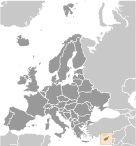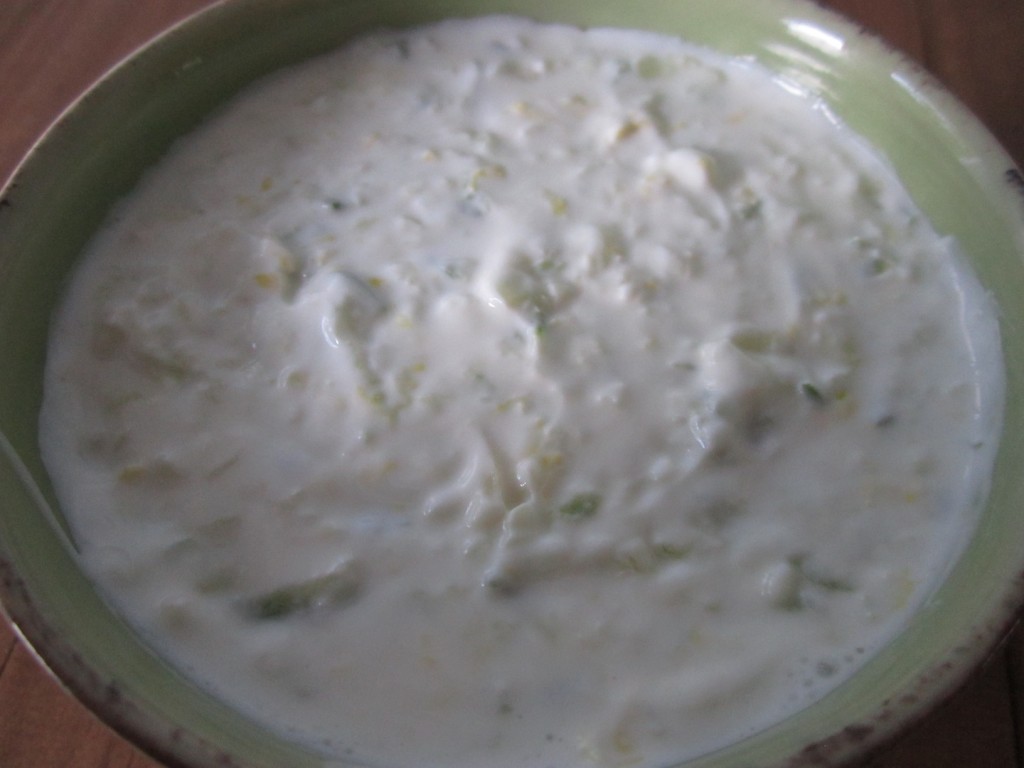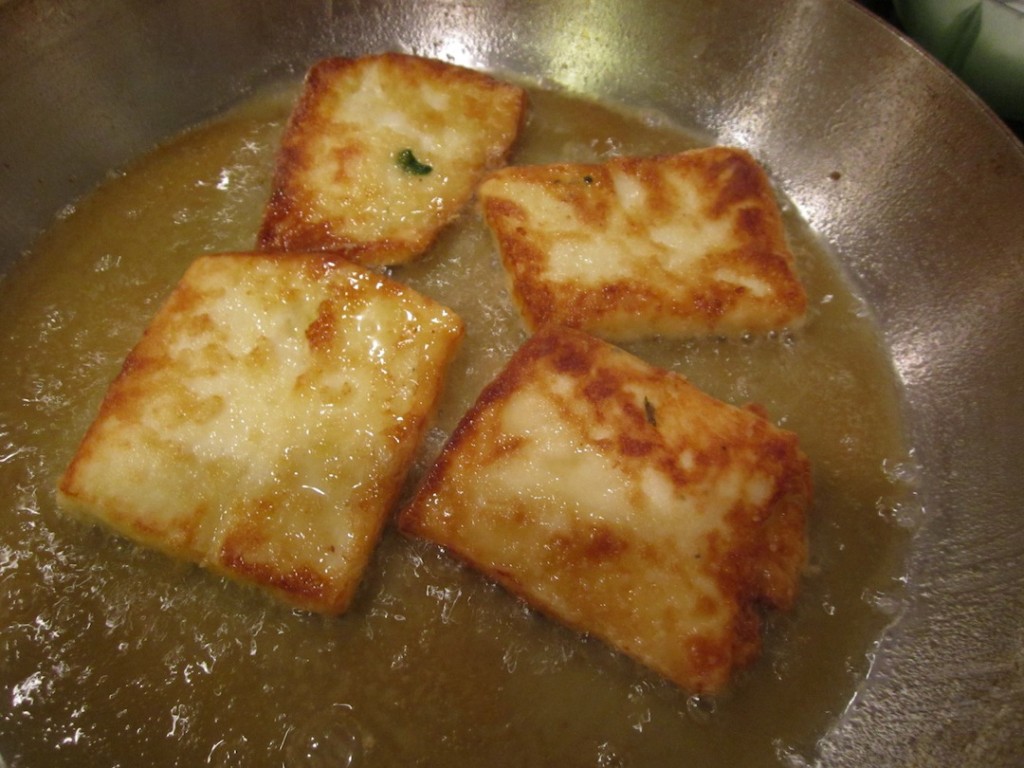 Coriander Spiced Pork Burger with Fried Halloumi Cheese and Tzatziki
Coriander Spiced Pork Burger with Fried Halloumi Cheese and Tzatziki
Staying with the island theme, we move on to Cyprus, an island nation in the Mediterranean. Based on Google® images, wow, what a beautiful place. Another one for my fantasy vacation list! Cyprus was a British colony until 1960. The people of Cyprus are primarily Greek 77% and Turkish 18%. These two groups have not coexisted peacefully over the years. In fact there is a Turkish enclave that has declared itself independent (after some fighting) in 1983. They call themselves the Turkish Republic of Northern Cyprus and are not recognized by any international body except Turkey. The island was accepted into the EU in 2004, including any Turks that can prove Cypriot citizenship. The UN has been trying to get the Turkish and Greek Cypriots to unite for years. Talks are still ongoing but from what I can tell, violence seems to have subsided. Yeah – definitely on the fantasy vacation list! (on the map it’s that little dot in the far right hand corner that is vaguely orange and yellow)
I have to apologize to the Muslim minority of Cyprus; I decided to go with pork for this burger based on the dominant flavors of Cypriot food. And, the Greek majority does seem to love pork. Another thing they love is cheese, all sorts of cheese. In particular, the good people of Cyprus created a cheese that can be fried and doesn’t melt. If you’ve been to Greek restaurants in the US, they make a dish called flaming saganaki where they throw ouzo on the fried cheese and light it on fire – yell “Opa”! Then put out the fire with lemon juice. It’s a little slice of heaven. Halloumi is one of the cheeses can be used for saganaki. I couldn’t resist frying me some cheese, but I did resist lighting it on fire.
So, with a nicely seasoned pork patty and an irresistible fried cheese, we just needed something to lighten the dish up a bit. Enter the tzatziki, a Greek inspired dish made with yogurt, garlic and cucumber. I added a kalamata olive bread just to give it some extra punch and overall the effect was bright flavors layered over a rich and creamy base. I went a little crazy on this one and tried grinding my own pork mixture for the burger – it turned out great, but I also made a version with the regular ground pork that you get at the store. The family couldn’t agree which was better – they were really similar with a slightly meatier taste to the fresh ground and a stronger coriander flavor in the store ground version – both worked well with the toppings, so I’ll give you both recipes and you can decided based on how adventurous you feel or how much time you have. If you don’t grind your own, this is one of the easier burgers to make, it’s perfect any time of the year, so enjoy!
Cyprus burger (fresh ground)
¾ cup Cabernet
¼ cup olive oil
2 cloves garlic minced
2 teaspoons whole coriander seeds
¼ teaspoon kosher salt
½ pound boneless pork loin cubed
½ pound boneless pork butt cubed
Combine the first five ingredients in a small sauce pan and heat until boiling. Remove from heat then cool until tepid. In a glass dish combine pork and wine mixture, cover and refrigerate 4-5 hours. Drain off excess liquid then grind the pork in a meat grinder (you want the coriander and garlic pieces in there too). Form four patties from the meat and grill in an oiled non-stick skillet until cooked through. Top the burger per the recipe below.
Cyprus burger (store ground pork)
1 pound ground pork
1 teaspoon ground coriander
½ teaspoon kosher salt
8 slices olive bread or French bread
Olive oil
Fresh spinach
Sliced tomato
Tzatziki (recipe below)
Fried Halloumi (recipe below)
Mix pork, coriander and salt then form into four patties. Lightly oil a non-stick pan and grill each slice of bread on one side. In same pan cook the pork patties until cooked through. On four slices of bread layer enough spinach to cover the bread, then add two tomato slices. Next comes the cooked patties, then the Tzatziki then the Fired Halloumi. Top with the final slices of grilled bread.
Tzatziki
1 cup 2% Greek yogurt
5-6 cloves garlic crushed and minced
½ cup grated English cucumber drained
½ teaspoon kosher salt
Zest of one lemon
Combine all ingredients in a glass bowl and refrigerate for at least a half hour before using (the longer it sits the more the garlic flavor will come forward).
Fried Halloumi
4 slices of Halloumi cheese (about ¼ inch thick)
Flour
Olive oil
Fresh lemon juice
Dredge the Halloumi slices in flour (coat both sides). Heat enough olive oil to cover the pan to about ¼ inch deep until shimmering. Carefully place the cheese in the hot oil and fry until golden, then turn and fry the other side. Remove from oil and place on paper towel to drain. Squeeze fresh lemon juice on each slice. Serve hot.
©Copyright 2011 Linda Monach






Flaming Saganaki! Sounds like some curse word. Never heard about that Europe or Greece (never been to Cyprus tough, thought it seems a bit touristy, yet it’s probably lovely). Must be a really Greek American thing.
What does the flour do for the Haloumi? I’m only used to grilling it outdoors. Not a fan of Haloumi though although I think it can be good – so any way to make it better is appreciated!
Cypriot cuisine has quite more Middle Eastern character than Greek or Turkish cuisine even though it seems quite similar to those, it’s more unique than that. Things like Bulgur and hummus is found there but not common in Greece. There’s quite a few ingredients from Cyprus that you won’t find in the nearby areas. Like many types of preserved meats, cheeses – rare fruits, carob seeds and taro roots. They seem to have a lot of their own stuff.
According to Wikipedia, flaming saganaki originated in Chicago’s Greektown. Chicago is where I first had it (they seem to serve it at all Greek restaurants there) – apparently frying cheese isn’t enough for Americans, we have to set it on fire!
As for the flour, I admit that I didn’t try frying without the flour as every recipe I found called for dredging in flour. What it does give you is a little bit of a crust that holds on to the taste of the olive oil and the lemon a little more than I imagine just the cheese would. I have some haloumi left over, I’ll try a side by side and get back to you with a more definitive answer some time this week (my daughter has a bad cold, so my cooking time is limited, spending most of my time with her).
It’s interesting that you say there’s a lot of Middle Eastern character to Cypriot food (and given your extensive travels I’m sure you’re right), I didn’t find a lot of Middle Eastern flavors noted in my research. It is the downside to doing all my research on the Internet, if only I could convince my husband (and my accountant) that I need to visit each of the countries to get a really good sense of the food 🙂 Most of what I found felt very Greek, so my final burger has a pretty Greek feel to it too. Or it could be that those were just the recipes and flavors that I was drawn to (since I love Greek food). Either way, it’s on to Czech Republic. I’m looking forward to closing out the Cs and moving on to Ds.
I finally did a side by side of dredging in flour and not dredging. The difference is small – you get a great flavor and nice browning either way. The only difference is that the dredged cheese holds on to the lemon flavor while the non-dredged doesn’t hold it as well. Since I like the lemon, I vote for dredging. Thanks for giving me an excuse to eat fried cheese for lunch (and no, I didn’t set it on fire) 🙂
Thanks! I actually did that too yesterday and agree with you that some light coating of flour is quite good.
I also found that the Haloumi pieces that wasn’t coated in flour didn’t hold it shape as good as the ones which was coated. But I like to fry Haloumi quite a long time on lower heat to make it melt a bit more.
As for middle eastern influence on Cypriot cuisine, Haloumi is a fine example as the cheese isn’t traditionally found in Greece nor Turkey but is apparently originating in Egypt and found in places like Iraq and Palestine where it’s called “Halluk” or “hallim”. Also Arab dishes like fattoush, falafel, hummus or other middle eastern dishes can be found on Cypriot tables.
It’s always great to have a reason to fry up some cheese! Now I’m going to have to try the low and slow you mention, I’ve always cooked it at a pretty high temp and quickly. Off to the store to buy more Haloumi!
Pingback: Albania burger recipe | burgers here and there